Peripheral Nervous System
What Is the Peripheral Nervous System?
The peripheral nervous system (PNS) is a vital part of the nervous system, responsible for connecting the central nervous system (CNS) to the rest of the body. It comprises a network of nerves and ganglia that relay information between the brain and spinal cord and the sensory organs, muscles, and organs.
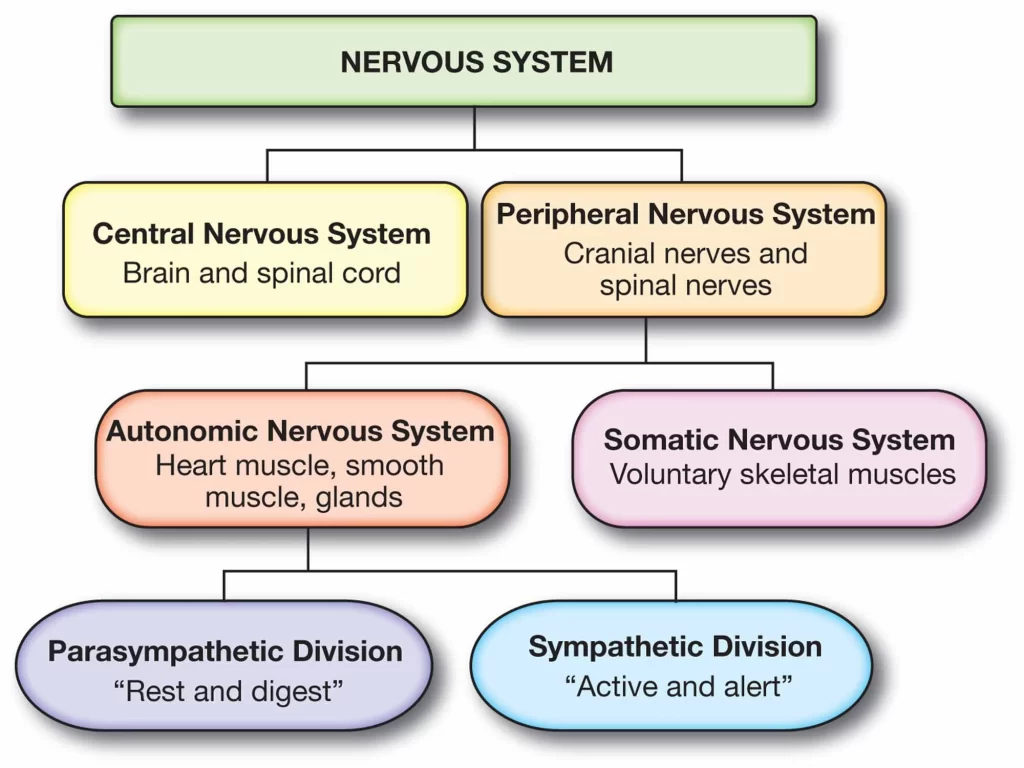
The central nervous system & the peripheral nervous system are the main division of the nervous system. The central nervous system encompasses the brain and spinal cord, while the peripheral nervous system consists of a vast network of nerves that extend from the brain and spinal cord to various parts of the body, including muscles and organs.
The primary role of the PNS is to establish a vital connection between the CNS and the organs, limbs, and skin. Its extensive network of nerves enables the brain and spinal cord to receive sensory information from the external environment and send motor commands to different body parts, allowing us to respond to various stimuli.
The peripheral nervous system serves four primary functions:
- Regulating autonomic body functions: The PNS controls involuntary processes, such as heart rate, blood pressure, respiratory rate, and digestion, which occur without conscious effort.
- Facilitating motor movements: It coordinates and controls voluntary movements by transmitting signals from the CNS to the muscles, enabling us to walk, talk, grasp objects, and perform other actions.
- Managing digestion: The PNS plays a crucial role in the digestive process by regulating gut motility, secretion of digestive enzymes, and other functions necessary for proper digestion and nutrient absorption.
- Relaying sensory information to the central nervous system: It acts as a bridge between the external world and the CNS, conveying sensory data from the sense organs (e.g., eyes, ears, skin) to the brain, enabling us to perceive and interpret our surroundings.
Several processes are under the purview of the peripheral nervous system, such as pupillary reflex (dilating or constricting pupils in response to light), activating the sweat response, regulating blood flow to various organs and tissues, and modulating heart rate to meet the body’s demands.
By continuously facilitating communication between the brain and the rest of the body, the peripheral nervous system plays a crucial role in maintaining homeostasis and allowing us to interact effectively with our environment.
What is PNS made of?
The peripheral nervous system comprises a diverse array of nerve cells and structures. It includes both the peripheral nerves and cranial nerves, which act as command centers, utilizing specialized neurons to transmit and relay signals throughout the nervous system via axons and dendrites. Let’s delve deeper into the main cell types present in the peripheral nervous system:
- Neurons:
Neurons play a crucial role in sending and relaying signals across the nervous system using a combination of electrical and chemical signals. Each neuron consists of several key components:
- Cell body: This serves as the central part of the neuron, housing its vital organelles and genetic information.
- Axon: A long, arm-like extension emanating from the cell body. At the axon’s terminal, electrical signals are converted into chemical signals at the synapses, facilitating communication with neighboring nerve cells.
- Dendrites: These are small, branch-like extensions (their name is derived from the Latin word for “tree-like”) that protrude from the cell body. Dendrites act as receptors, receiving chemical signals from the synapses of other nearby neurons.
- Myelin: A thin, protective layer composed of fatty compounds, which surrounds the axons of many neurons. Myelin acts as an insulating sheath, enhancing the speed and efficiency of signal transmission.
The complexity of neuron connections is astounding, as a single neuron’s dendrites can establish connections with thousands of other synapses. The length of neurons varies depending on their location within the body and their specialized functions.
- Glial Cells:
Glial cells, pronounced as “glee-uhl” cells, serve diverse purposes throughout life. During development, they play a vital role in the growth and maintenance of neurons. Additionally, these cells regulate the functionality of neurons and protect the nervous system from infections. One of their essential tasks is creating the myelin coating that surrounds neurons’ axons, bolstering their protection and facilitating efficient signal transmission.
Structures of the Peripheral Nervous System
The peripheral nervous system is indeed divided into two essential components: the somatic nervous system and the autonomic nervous system, each serving distinct and vital roles in the overall functioning of the peripheral nervous system.
The Somatic Nervous System:
The somatic nervous system is responsible for transmitting sensory and motor information to and from the central nervous system. Its name is derived from the Greek word “soma,” which means “body.”
Within the somatic system, two main types of neurons are at work:
- Motor neurons (efferent neurons): These neurons carry signals from the brain and spinal cord to the muscle fibers throughout the body, enabling voluntary movements and allowing us to physically respond to stimuli in our environment.
- Sensory neurons (afferent neurons): These neurons carry sensory information from the nerves to the central nervous system, conveying data about the external environment to the brain and spinal cord, thereby facilitating our perception of the world around us.
The Autonomic Nervous System:
The autonomic nervous system is responsible for regulating involuntary bodily functions, such as blood flow, heartbeat, digestion, and breathing. This system controls aspects of the body that typically operate without conscious control, ensuring these vital functions continue without requiring conscious effort. The autonomic nervous system (ANS) can be also separated into 2 units:
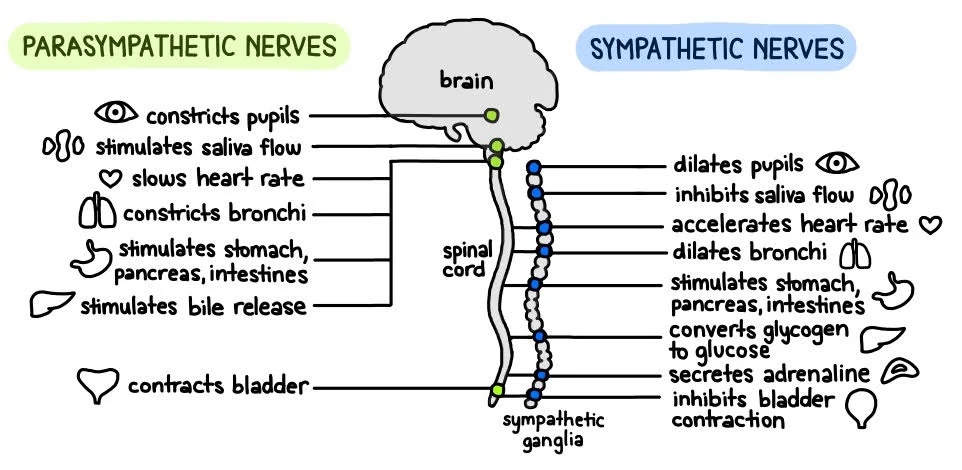
- Sympathetic system: This branch is in charge of activating the “fight-or-flight” response when the body encounters potential threats or stressors. It prepares the body to react by increasing heart rate, accelerating breathing, redirecting blood flow to muscles, triggering sweat secretion, and dilating pupils, all in readiness for immediate action.
- Parasympathetic system: This branch works to maintain normal body functions and conserve physical resources during times of rest. After the threat or stress has passed, the parasympathetic system slows the heart rate, reduces the breathing rate, decreases blood flow to muscles, and constricts pupils, allowing the body to return to a state of equilibrium and rest.
Together, the somatic and autonomic nervous systems form a complex network that ensures effective communication between the central nervous system and the rest of the body, allowing us to interact with our environment, respond to stimuli, and maintain vital physiological processes seamlessly.
The function of the Peripheral Nervous System
The main function of the peripheral nervous system (PNS) is to specify a strong relation between the brain, spinal cord, the whole body, & the outer environment. This complicated network depends on nerves that transfer information from different sensory receptors, for example, those in the eyes, ears, skin, nose, & tongue, to the central nervous system (CNS). Also, stretch receptors & nociceptors in muscles, glands, & inner organs contribute to this details relay.
Upon receiving and integrating these diverse signals, the CNS formulates appropriate responses, which are conveyed back to the body through the motor nerves of the PNS. These motor nerves innervate effector organs, facilitating the contraction or relaxation of skeletal, smooth, or cardiac muscles, thus enabling voluntary movements and necessary physiological processes.
The autonomic nervous system, which is part of the PNS, plays a crucial role in maintaining internal homeostasis. It regulates vital functions like respiration, heart rate, blood pressure, digestion, reproduction, and immune responses. By modulating muscle contractility across the body, including sphincters in the digestive and excretory systems, cardiac muscles in the heart, and skeletal muscles for movement, the PNS ensures proper bodily function, voluntary actions, balance, and posture.
Furthermore, the peripheral nervous system controls the release of secretions from most exocrine glands, affecting various physiological processes. It also coordinates the muscles surrounding sense organs, thereby contributing to essential activities like chewing, swallowing, biting, and speaking.
In addition to facilitating normal functions, the PNS swiftly responds to noxious stimuli, protecting the body from harm. Whether it’s extreme temperature, pH levels, or pressure, the PNS initiates rapid reflexes that remove the body from potentially injurious situations.
Nerves of Peripheral Nervous System
General Nerve Structure
The peripheral nervous system is a complex network comprising nerves, ganglia, and plexuses. Nerves consist of multiple neurons’ axons bound together by connective tissue. Often, the axon is myelinated, thanks to the secretion of a phospholipid by a glial cell called the Schwann cell. This myelin sheath provides insulation and enhances the speed of nerve signal transmission. The Schwann cell’s thin covering, known as the neurilemma or neurolemma, forms the innermost layer protecting the axon.
In the structure of a nerve, blood capillaries, and other connective tissues surround the neurilemma, forming the endoneurium. Multiple axons are grouped to form bundles called fascicles, which are held together by fibrous tissue known as the perineurium. The entire nerve, comprising numerous axon bundles, is further encased in a fibrous epineurium, providing overall protection and support.
Neurons’ cell bodies, or soma, also cluster together within the nerve and are covered by the epineurium, forming swellings known as ganglia. In the autonomic nervous system, these ganglia serve as crucial sites for synaptic transmission between two neurons, facilitating the communication necessary for autonomic functions.
PNS Nerves
The major nerves that create the peripheral nervous system contain:
- Brachial plexus
- Femoral nerve
- Lateral femoral cutaneous nerve
- Peroneal nerve
- Sciatic nerve
- Spinal accessory nerve
- Tibial nerve
Spinal Nerves
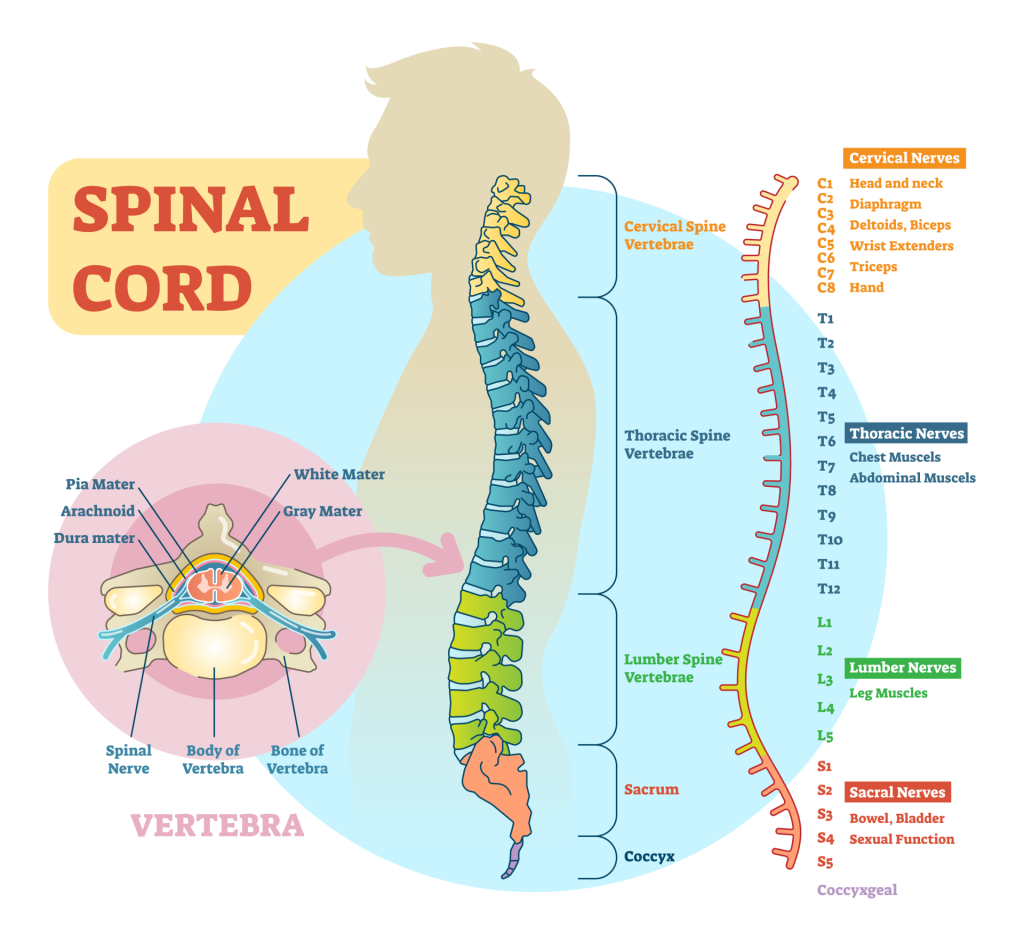
The spinal nerves are essential components of the peripheral nervous system, with thirty-one pairs emerging laterally from the spinal cord. Individually pair of spinal nerves communicate to a precise component of the spinal cord & is prescribed consequently resulting in 8 cervical nerves, 12 thoracic nerves, 5 lumbar nerves, 5 sacral nerves, & 1 coccygeal nerve.
The connection between each spinal nerve and the spinal cord is facilitated by two roots: the dorsal root and the ventral root. The cell bodies of sensory neurons reside in clusters known as dorsal root ganglia, while the cell bodies of motor neurons are located in the gray matter of the spinal cord. Just before exiting the vertebral column, these two roots join together to form the spinal nerve.
What makes spinal nerves unique is their composition as mixed nerves, meaning they contain both sensory and motor components. Sensory neurons carry information from sensory receptors to the spinal cord, while motor neurons transmit signals from the spinal cord to muscles and glands, allowing for movement and other physiological responses.
The spinal nerves are integral to our ability to interact with the environment and respond to various stimuli. They play a crucial role in transmitting sensory information to the central nervous system and coordinating motor commands, enabling us to perform voluntary movements and involuntary functions necessary for maintaining homeostasis. The organization of these spinal nerves ensures efficient communication between the brain, spinal cord, and the rest of the body, contributing to our overall functioning and adaptability.
Cranial Nerves
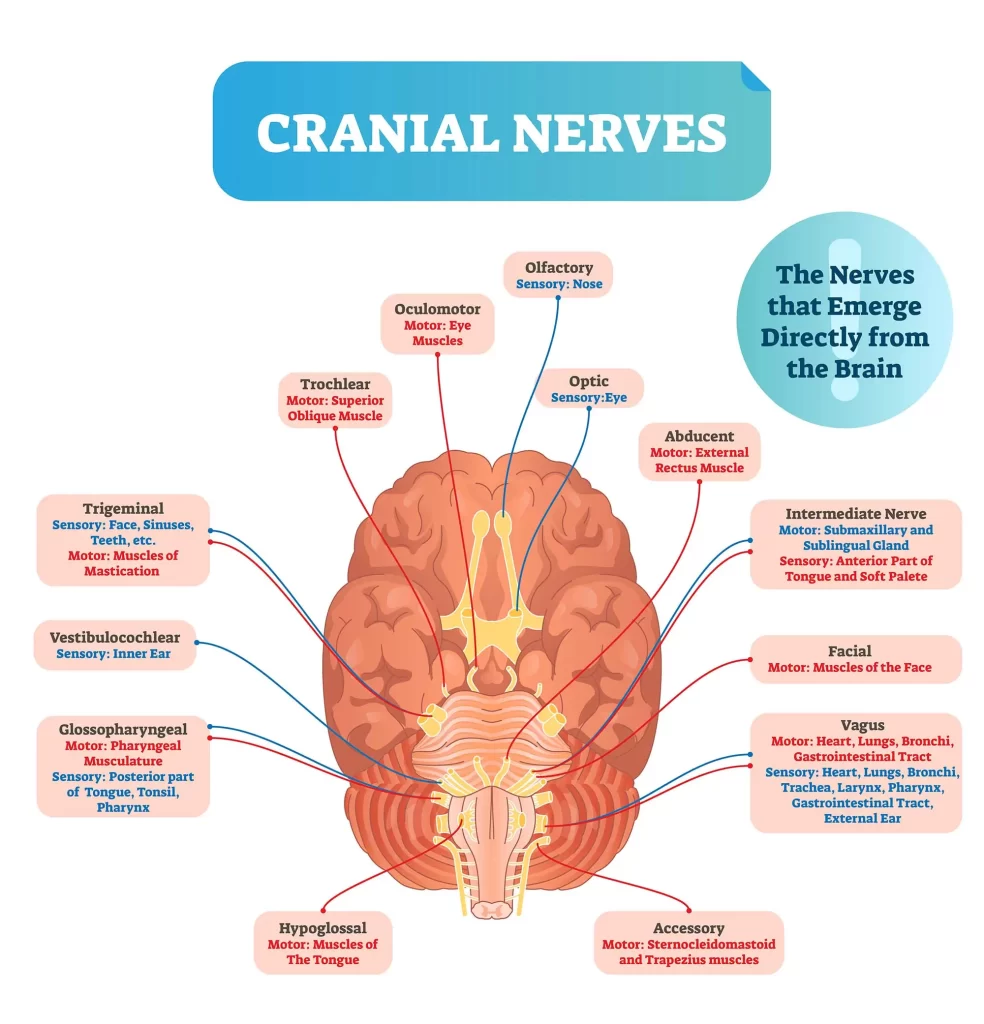
12 pairs of cranial nerves arise from the lower surface of the brain, & all except the vagus nerve expire via the foramina of the skull to innervate formats in the head, neck, & facial region.
Designated by both name and Roman numerals based on their appearance on the inferior brain surface, most cranial nerves contain both sensory and motor components. Three nerves are associated with special senses like smell, vision, hearing, and equilibrium, and exclusively carry sensory fibers. Five other nerves are primarily motor, but they also have sensory fibers for proprioception. The remaining four nerves comprise a significant combination of both sensory and motor fibers.
Among these cranial nerves, the eighth cranial nerve, also known as the vestibulocochlear nerve or balance nerve, can sometimes give rise to benign fibrous growths called acoustic neuromas. These tumors are non-malignant, meaning they do not spread to other parts of the body. However, their location deep inside the skull, adjacent to vital brain centers in the brain stem, can lead to the involvement of surrounding structures linked to critical functions. These tumors usually grow slowly over the years, but in some cases, their growth rate can be more rapid, leading to faster symptom development. Symptoms are often mild, and patients may not be diagnosed until some time after the tumor has formed. Regular MRI scans are commonly used to monitor the growth of acoustic neuromas over the years.
12 pairs of cranial nerves are:
- Olfactory nerves: Sensory nerves related to the sense of smell.
- Optic nerves: Sensory nerves related to the sense of sight.
- Oculomotor, trochlear, and abducens nerves: Motor nerves responsible for voluntary eye movements.
- Vestibulocochlear nerves: Sensory nerves related to the sense of hearing, sound perception, orientation, and balance.
- Glossopharyngeal and hypoglossal nerves: Sensory and motor nerves responsible for tongue muscle movements and sense of taste.
- Vagus nerves: Both sensory and motor nerves are responsible for movements of the lower head, throat, neck, chest, and abdomen, as well as autonomic functions like breathing and heart rate.
- Spinal accessory nerves: Both sensory and motor nerves are responsible for head, neck, and shoulder muscles’ movement.
- Facial nerves: Sensory and motor nerves related to taste buds and facial expressions.
- Trigeminal nerves: Sensory and motor nerves transmit signals from the eyes, teeth, face, lower jaw, and muscles involved in chewing.
Diseases of the Peripheral Nervous System
Numerous diseases and disorders can have an impact on the peripheral nervous system (PNS), leading to a wide range of symptoms and complications involving sensory and motor functions.
Some of the illnesses that can impact the PNS contain:
- Amyotrophic lateral sclerosis (ALS): A progressive neurodegenerative disease that affects motor neurons, leading to muscle weakness, paralysis, and difficulties in speech, swallowing, and breathing.
- Carpal tunnel syndrome: Compression of the median nerve in the wrist, causing symptoms like pain, tingling, and weakness in the hand and fingers.
- Diabetes: Long-term uncontrolled diabetes can lead to peripheral neuropathy, causing numbness, tingling, and pain in the extremities.
- Epstein-Barr virus: Infection with this virus can, in rare cases, cause inflammation of nerves, leading to neurological symptoms.
- Guillain-Barre syndrome: An autoimmune disorder in which the immune system attacks the peripheral nerves, resulting in weakness, numbness, and paralysis, often starting in the legs and spreading upwards.
- Lupus: An autoimmune disease that can cause inflammation of peripheral nerves, leading to various neurological symptoms.
- Peripheral neuropathy: A general term for conditions that damage peripheral nerves, leading to symptoms like numbness, tingling, and weakness.
- Peripheral nerve injuries: Traumatic injuries to the peripheral nerves can cause loss of sensation and muscle function in the affected area.
- Rheumatoid arthritis: An autoimmune disorder that can lead to nerve compression or inflammation, causing pain and weakness.
- Thoracic outlet syndrome: Compression of nerves or blood vessels in the upper chest, leading to symptoms like pain, tingling, and weakness in the arm.
- Tumors: Tumors can compress or damage peripheral nerves, leading to a variety of neurological symptoms.
- Vitamin deficiency: Deficiencies in certain vitamins, such as B vitamins, can cause peripheral neuropathy and other nerve-related problems.
Common signs and symptoms of peripheral nervous system conditions
The symptoms arising from peripheral nervous system problems are closely linked to the specific types of nerves that are affected.
When motor nerves suffer damage, they can impact the muscles and lead to the following symptoms:
- Weakness: The affected muscles may lose strength and become difficult to control.
- Cramps, Spasms, Tremors, or Twitches: Uncontrolled muscle contractions or movements can occur, causing discomfort and involuntary twitching.
- Wasting (Muscle Atrophy): Muscles may undergo a shrinkage or wasting process due to the lack of nerve stimulation.
- Loss of Control: The ability to control certain muscles or perform precise movements may be compromised.
In contrast, damage to sensory nerves gives rise to a distinct set of symptoms:
- Little or No Sense of Touch: The affected area may experience a reduced sense of touch, leading to sensations like wearing a glove or a loss of temperature and vibration sensitivity. Simple tasks such as buttoning a shirt or walking can become challenging if the hands or feet are affected.
- Tingling or Numbness (Paresthesia): This sensation is akin to the feeling of an arm or leg “falling asleep” and is often described as “pins and needles” in the affected region.
- Neuropathic Pain: Also known as nerve pain, this type of discomfort is characterized by burning or sharp sensations around the affected area. It can be severe enough to disrupt sleep or daily routines. Conditions like allodynia may cause pain from even light contact with soft objects, such as clothing or bedding.
When autonomic nerves sustain damage, various organs and systems may be affected:
- Circulatory System: Autonomic nerve damage can disrupt the body’s ability to regulate blood pressure, leading to fluctuations in blood pressure levels.
- Digestive System: Depending on the location of the affected part of the digestive tract, autonomic nerve damage may result in difficulties digesting food.
- Skin and Temperature Control: People with autonomic nerve damage may experience discomfort in regulating body temperature, making it challenging to feel comfortable in hot environments. Additionally, they may suffer from excessive sweating (hyperhidrosis) or insufficient sweating (anhidrosis).
Diagnosis of peripheral nervous system conditions
Numerous diagnostic tests are available to identify conditions affecting the peripheral nervous system. The initial step typically involves a comprehensive neurological examination, during which your healthcare provider evaluates various aspects of your body, with a particular focus on the arms, hands, legs, and feet.
Several common tests used for diagnosis include:
- Blood Tests: These tests are valuable for detecting a wide range of issues, including immune system disorders and exposure to toxins and poisons, particularly heavy metals like mercury or lead.
- Nerve Conduction Tests: Nerve conduction studies assess the speed and efficiency of nerve signals as they travel along specific nerves. This test helps identify nerve damage or compression.
- Electromyogram (EMG): An electromyogram estimates the electrical movement of muscles. It helps in analyzing neuromuscular disorders & deciding if there is nerve injury/muscle dysfunction.
- Nerve Ultrasound: This non-invasive imaging technique uses sound waves to visualize and assess peripheral nerves, helping to detect abnormalities or compressions.
- Nerve Biopsy: In certain cases, a nerve biopsy may be performed to analyze a small sample of nerve tissue under a microscope. This helps in diagnosing conditions that affect the nerves at a cellular level.
- Genetic Testing: Genetic tests can identify inherited conditions or genetic mutations that may contribute to peripheral nervous system disorders.
- Magnetic Resonance Imaging (MRI): MRI scans provide detailed images of the nervous system, helping to identify structural abnormalities, tumors, herniated discs, or other issues that may be affecting the nerves.
Common treatments for peripheral nervous system conditions
The treatment options for peripheral nervous system problems are as diverse as the conditions themselves. Often, addressing the underlying cause of these issues can alleviate their impact on the nervous system. However, it is essential to recognize that different conditions may require specific and tailored treatments, as what works for one problem may not be effective for others.
Potential treatments encompass a wide range of approaches, including but not limited to:
- Medications: There are various medications available to address peripheral nervous system problems. These medications can be administered through injections, oral forms, or slow-release patches, depending on the specific condition and its severity.
- Surgery: In some cases, surgical interventions may be necessary to reconnect severed nerves or relieve pain caused by trapped nerves.
- Transcutaneous Electrical Nerve Stimulation (TENS): This technique involves using a mild electrical current to interfere with the transmission of pain signals by the nerves, providing relief from discomfort.
- Nerve Ablation: In certain situations, intentionally damaging a malfunctioning nerve through ablation may help treat chronic pain by interrupting the nerve’s abnormal signaling to the brain.
- Physical Therapy: Physical therapy plays a crucial role in aiding recovery from injuries or medical procedures and can help manage pain symptoms. Additionally, it assists individuals in adapting to nervous system changes and regaining mobility and function.
- Acupuncture: This traditional Chinese practice, involving the insertion of tiny needles at specific points on the body, is increasingly being utilized in modern medicine. Medical doctors, particularly anesthesiologists/pain management professionals, may contain acupuncture to regale different neurological difficulties.
- Devices and Wearable Equipment: Medical devices like braces, canes, walkers, and prescribed footwear can provide support and aid mobility for individuals with peripheral nervous system issues.
Prevention for peripheral nervous system conditions
Prevention plays a crucial role in safeguarding against many conditions that can lead to peripheral nervous system damage. By adopting proactive measures, you can significantly reduce the risk of developing such problems.
- Maintain a Balanced Diet: A well-balanced diet is essential for overall health, including the nervous system. Ensure you consume sufficient nutrients, especially vitamin B12, which is vital for nerve health. Conversely, avoid excessive intake of certain vitamins, such as B6, as high levels can be toxic and lead to peripheral neuropathy.
- Stay Physically Active and Manage Weight: Engaging in regular physical activity not only promotes overall well-being but also helps prevent injuries that could potentially cause nerve damage. Maintaining a healthy weight is particularly important in preventing Type 2 diabetes, which can lead to peripheral nerve damage over time.
- Utilize Safety Equipment: To protect yourself from injuries that can result in nerve damage, ensure you use appropriate safety equipment during work and recreational activities. This precautionary measure can prevent or mitigate the severity of potential injuries.
- Manage Chronic Conditions: If you have a chronic condition known to affect the peripheral nerves, such as Type 2 diabetes, adhere to your healthcare provider’s recommendations for managing the condition. Proper management can help limit its impact on your nervous system and potentially delay its progression.
FAQ
What are the differences between the PNS & CNS?
The nervous system contains 2 major components: the central nervous system (CNS) & the peripheral nervous system (PNS). The central nervous system contains 2 organs, the brain & spinal cord.
The peripheral nervous system is everything else & contains nerves that travel from the spinal cord & brain to provide the face & the rest of the body.
What are the 3 major organs of the peripheral nervous system (PNS)?
The parts of the peripheral nervous system (PNS) are the nerves & ganglia. Nerves are bundles of nerve fibers, which are the same as muscles are bundles of muscle fibers. Cranial nerves & spinal nerves grow from the central nervous system (CNS) to peripheral organs for example muscles & glands.
What are the 6 major nerves of the peripheral nervous system (PNS)?
The major nerves that make up the peripheral nervous system (PNS) contain:
Brachial plexus.
Femoral nerve.
The lateral femoral cutaneous nerve.
Peroneal nerve.
Sciatic nerve.
The spinal accessory nerve.
Tibial nerve.
What are the 5 senses of the peripheral nervous system (PNS)?
Nerves dispatch the signals to the brain, which analyzes them as sight (vision), sound (hearing), smell (olfaction), taste (gustation), & touch (tactile perception).
Which is the largest nerve in the human body?
Sciatic Nerve
The sciatic nerve is the most elongated, biggest nerve in the human body. The sciatic nerve origins begin in the lower back & run down the back of each leg. Sciatica is the pain/discomfort if the sciatic nerve obtains compressed/pinched.
What is a nerve cell called?
The primary unit of transmission in the nervous system is the nerve cell (neuron). Separately nerve cells include the cell body, which contains the nucleus, a main branching fiber (axon) & numerous smaller branching fibers (dendrites).

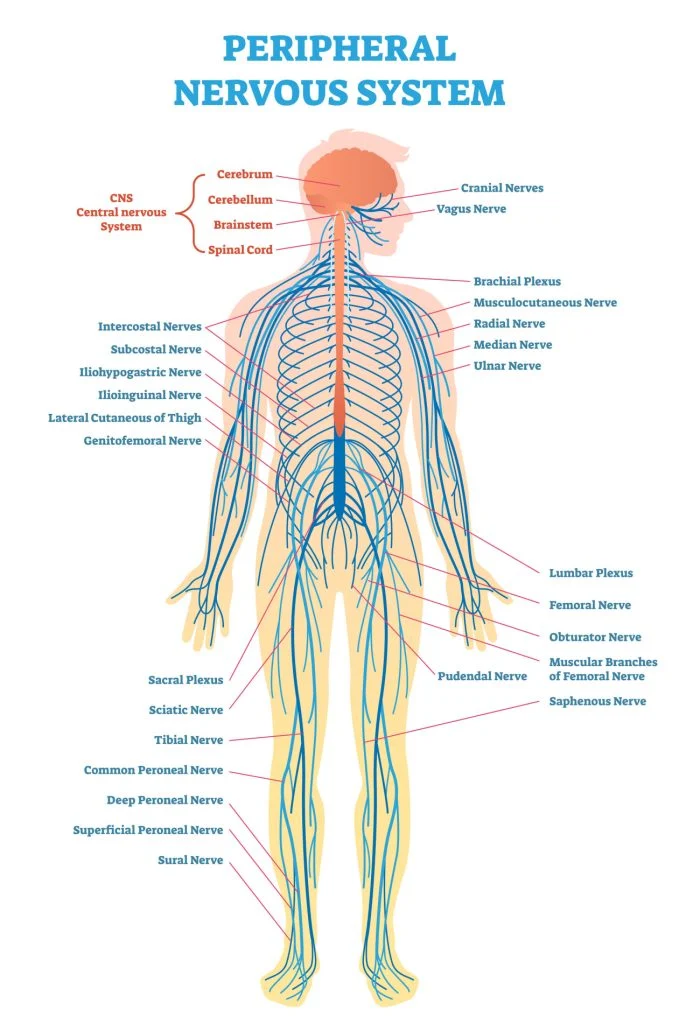
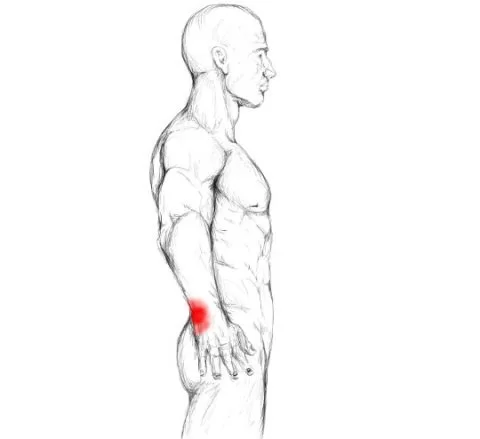
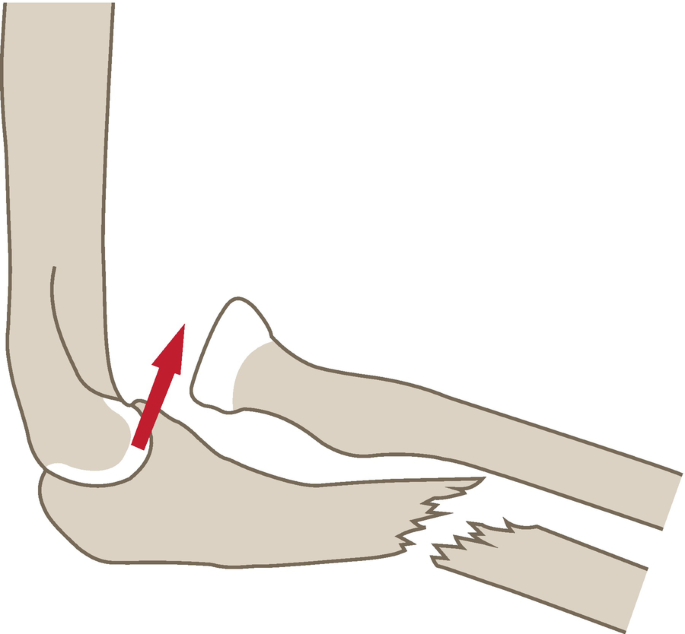


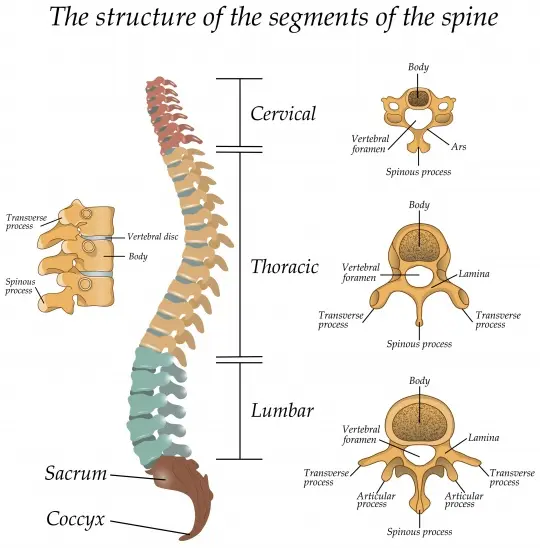
2 Comments